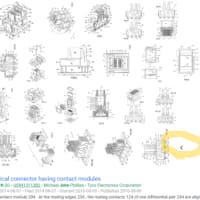US11433022(APRECIA PHARMACEUTICALS LLC [US])
[0138] In various embodiments, a dosage form illustrated in FIG. 1 can be formed using an additive manufacturing apparatus, system and process.
【0069】
様々な態様において、図1に示す剤形は、付加造形装置、システム及びプロセスを用いて形成することができる。
One non-limiting example of an additive manufacturing process, and associated apparatus and system, is a three-dimensional printing (3DP) building process.
付加製造プロセス、並びに関連する装置及びシステムの非限定的な一例として、3次元印刷(3DP)構築プロセスがある。
Generally, 3DP systems include a powder layering system that forms a layer of build powder, and a printing system that applies a printing liquid, typically containing a binder material, to the layer of build powder according to a pre-determined pattern,
一般に、3DPシステムは、造形粉末の層を形成する粉末層化システム、及び典型的にはバインダ材料を含む印刷液を所定のパターンに従って造形粉末の層に塗布する印刷システムを含み、
thereby binding the build powder and forming a printed or bound-powder layer.
それらによって、造形粉末を結合し、印刷した層又は結合粉末層を形成する。
US11117212(UNIV ARIZONA STATE [US])
[0061] Ultrasonic Additive Manufacturing is a process that alternates between ultrasonic welding of layers of metal foil and CNC milling to produce near-net shape and net shape parts.
【0048】
超音波付加製造法は、金属箔の層の超音波溶接とCNCフライス削りを交互に行い、それによってニアネットシェイプ部品とネットシェイプ部品を製造するプロセスである。
This process utilizes the acoustic softening of metal and the enhancement in solid-state diffusion to create stress-free metallurgical bond between layers of metal foil, followed by mechanical milling at each layer to form parts layer by layer.
このプロセスは金属の音響軟化と固体状態での拡散の増進を利用し、それにより金属箔の層どうしの間での応力の無い冶金的結合を形成し、次いで、各々の層において機械削りを行い、それにより層ごとに部品を形成する。
Though an excellent example of combing traditional and advance manufacturing processes, this approach creates large amounts of waste materials, and the use of the foil raw material renders the simultaneous use of metal and polymer impractical.
従来の製造法と進歩した製造法を組み合わせた優れた例ではあるが、このやり方によれば大量の廃棄物が生じ、また箔の原材料の使用は金属とポリマーの同時使用を不可能にする。
Micro-extrusion-based additive modeling and ink droplet printing processes such as electrodynamic jetting are processes currently in development by the nano-/micro-manufacturing community.
微細押出しに基づく付加造形法および電気力学的噴射のようなインク小滴造形法は、ナノ(あるいはミクロ)製造のコミュニティーによって現在開発中のプロセスである。
These processes are capable of producing hybrid metal-polymer heterogeneous materials, and utilize metal particles mixed-in with polymer bases for printing to obtain the required electrical properties of the final product.
これらのプロセスによれば、混成金属・ポリマー不均質材料を製造することができ、また造形のための金属粒子とポリマー系との混合物を利用し、それにより最終製品について必要な電気的性質が得られる。
US11643555(ELKEM SILICONES USA CORP [US])
“Additive manufacturing (AM)” is defined as
【0091】
「付加製造(Additive manufacturing、AM)」は、
“a process of joining materials to make objects from 3D model data, usually layer upon layer, as opposed to subtractive manufacturing methodologies.
「減法製造方法論とは対照的に、材料を結合して3Dモデルデータから物体を作成するプロセスであり、通常は層を重ねるプロセスである。
Synonyms associated with, and encompassed by, 3D printing include additive fabrication, additive processes, additive techniques, additive layer manufacturing, layer manufacturing, and freeform fabrication.”
3D印刷に関連し、含まれる同義語には、付加造形、付加プロセス、プロセス技術、技術層製造、層製造、フリーフォーム造形などがある。」
と定義される。
Additive manufacturing (AM) may also be referred to as rapid prototyping (RP).
付加製造(AM)は、ラピッドプロトタイピング(rapid prototyping、RP)とも呼ばれる。
As used herein, “3D printing” is generally interchangeable with “additive manufacturing” and vice versa.
本明細書で使用される「3D印刷」は、一般に「付加製造」と交換可能であり、その逆も同様である。
EP4052021(INKBIT LLC [US])
[0050] Applications of scanning improvements described below
【0046】
後述するスキャン改良の適用例は、
include three- dimensional additive fabrication in an optical scanning feedback approach in which
during fabrication, the achieved properties of a partially fabricated object are scanned, and information gained from that scanning is used to modify further addition of material so that the object matches the desired characteristics, for instance in dimension or composition.
造形中、部分的に造形された物体の達成された性質がスキャンされ、そのスキャンから得られた情報が、物体が例えば寸法又は組成において所望の特性に合うように材料の更なる付加を変更するのに使用される、
光学スキャンフィードバック手法における三次元付加造形を含む。


























※コメント投稿者のブログIDはブログ作成者のみに通知されます